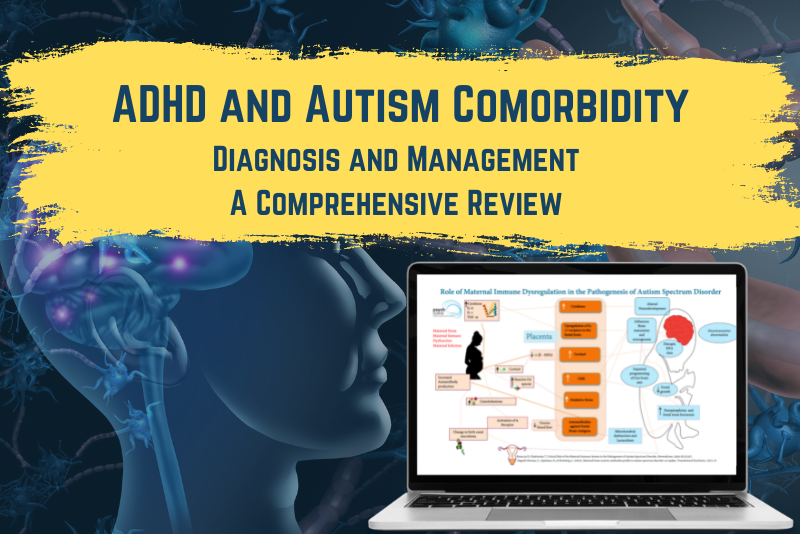Co-occurrence Of ADHD, Autism, And Intellectual Disability In Adults: A Comprehensive Study

Table of Contents
Prevalence and Diagnostic Challenges of Co-occurring Conditions
Understanding the prevalence of ADHD, autism, and ID individually and in combination is crucial. ADHD prevalence in adults varies, but studies suggest a significant portion of the population is affected. Similarly, autism prevalence in adults is also substantial, with ongoing research refining our understanding of its spectrum. Intellectual disability statistics show a range of severity, impacting various aspects of cognitive functioning. The combined occurrence of these three conditions presents unique diagnostic complexities.
- Overlapping symptoms: ADHD, autism, and ID share some overlapping symptoms, such as difficulties with attention, social interaction, and executive functioning. This overlap can make differential diagnosis challenging, leading to misdiagnosis or delayed diagnosis.
- Comorbidity masking: One condition might mask the symptoms of another. For instance, the inattentive presentation of ADHD might be overlooked in an individual with autism, whose social communication challenges are the primary focus.
- Need for comprehensive assessment: Accurate diagnosis requires a multidisciplinary approach, involving psychiatrists, psychologists, neuropsychologists, and other specialists. A comprehensive assessment should include detailed interviews, behavioral observations, and neuropsychological testing.
- Adult-specific diagnostic criteria: It's important to note that diagnostic criteria for ADHD, autism, and ID can differ slightly between children and adults. Clinicians must use the appropriate criteria for adult populations.
Differential Diagnosis and Challenges in Clinical Practice
Differential diagnosis of co-occurring ADHD, autism, and ID in adults presents significant clinical challenges. The subtle variations in symptom presentation and the complex interactions between conditions require careful consideration. For instance, distinguishing between inattentive ADHD and the cognitive limitations associated with ID can be particularly difficult. The use of standardized assessment tools and a thorough understanding of adult autism diagnosis challenges are essential for accurate diagnosis and appropriate intervention planning. Clinicians must also consider the impact of potential comorbidities, like anxiety or depression, which can further complicate the diagnostic process. "Differential diagnosis ADHD autism" is a crucial aspect of this process, requiring a nuanced understanding of each condition's specific characteristics and the ways in which they interact.
Associated Difficulties and Functional Impact
The co-occurrence of ADHD, autism, and ID significantly impacts daily functioning across various domains. The combined effects can lead to considerable challenges in several key areas:
- Social interaction and relationships: Individuals may struggle with social communication, understanding social cues, and forming and maintaining relationships due to a combination of social deficits associated with autism and impulsivity/hyperactivity from ADHD, potentially compounded by cognitive limitations from ID.
- Employment and education: Difficulties with attention, organization, and executive function (common in all three conditions) can severely impact educational attainment and employment prospects. Maintaining a job or pursuing higher education may require significant support and adaptation.
- Independent living skills: Managing daily tasks like finances, hygiene, and household chores can be challenging. Individuals may require significant support to live independently.
- Mental health comorbidities: The co-occurrence of these conditions increases the risk of developing anxiety, depression, and other mental health disorders. "ADHD comorbidity depression" and "autism and anxiety" are well-documented associations that require careful monitoring and treatment.
Impact on Quality of Life
The combined effect of ADHD, autism, and ID can significantly reduce an individual's quality of life. Challenges in social, occupational, and personal domains contribute to decreased well-being and life satisfaction. The "quality of life ADHD autism ID" is often negatively affected, highlighting the urgent need for effective intervention strategies. The "impact of comorbid conditions" necessitates a holistic approach to care, focusing not just on symptom management but also on improving overall quality of life and well-being.
Effective Management Strategies and Interventions
Effective management of co-occurring ADHD, autism, and ID requires a comprehensive and individualized approach. Several interventions have proven beneficial:
- Behavioral therapies: Cognitive behavioral therapy (CBT) and other behavioral interventions can help individuals develop coping mechanisms for managing symptoms, improving social skills, and enhancing self-regulation.
- Medication management: Medication can be helpful in managing ADHD symptoms, such as inattention and hyperactivity. Other medications might be used to address associated conditions such as anxiety or depression.
- Educational and vocational support: Tailored educational and vocational support programs can help individuals reach their full potential and achieve their educational and career goals. These programs may include individualized learning plans, job coaching, and assistive technology.
- Social skills training: Social skills training programs can help individuals improve their social communication skills, understand social cues, and build positive relationships.
Integrated Care Models for Comprehensive Support
An "integrated care ADHD autism" model, involving multiple professionals working collaboratively, is crucial. A "multidisciplinary team approach" brings together psychiatrists, psychologists, educators, occupational therapists, and other specialists to provide comprehensive support. This collaborative approach ensures that each individual receives the tailored interventions they need to address their unique challenges.
Future Research Directions
Further research is needed to improve our understanding and management of co-occurring ADHD, autism, and ID in adults. Key areas for future research include:
- Early identification and intervention strategies: Early identification is crucial to improve outcomes. Research should focus on developing effective screening tools and early intervention programs.
- Development of specific diagnostic tools for adults: Adult-specific diagnostic tools are needed to improve diagnostic accuracy and reduce delays in diagnosis.
- Longitudinal studies to track outcomes: Longitudinal studies are essential to track the long-term effects of interventions and identify factors that predict positive outcomes.
- Exploring the effectiveness of various therapeutic interventions: More research is needed to evaluate the effectiveness of different therapeutic interventions, including the integration of various approaches.
Improving Understanding and Support for Adults with Co-occurring Conditions
"ADHD autism ID research" is critical to enhance our understanding of these co-occurring conditions. "Future directions in autism research," and research on ADHD and ID, should include a focus on developing more effective diagnostic tools, interventions, and support systems for adults. Advocacy efforts are crucial to raise awareness, increase access to services, and improve the lives of adults affected by these conditions.
Conclusion: Understanding the Co-occurrence of ADHD, Autism, and Intellectual Disability in Adults
This article has highlighted the prevalence, diagnostic challenges, associated difficulties, and management strategies for the co-occurrence of ADHD, autism, and ID in adults. Comprehensive assessment and integrated care approaches are crucial for providing effective support. Further research and advocacy are essential to improve the lives of adults affected by these conditions. Seek diagnosis for co-occurring ADHD, autism, and intellectual disability if you suspect you or someone you know may be affected. Learn more about the co-occurrence of ADHD, autism, and intellectual disability and find support for adults with co-occurring ADHD, autism, and intellectual disability through relevant organizations and healthcare professionals.

Featured Posts
-
 Pete Rose Pardon Trumps Statement And Its Implications
Apr 29, 2025
Pete Rose Pardon Trumps Statement And Its Implications
Apr 29, 2025 -
 Nyt Spelling Bee March 15 2025 Find The Pangram And Answers
Apr 29, 2025
Nyt Spelling Bee March 15 2025 Find The Pangram And Answers
Apr 29, 2025 -
 10 New Nuclear Reactors Approved Boosting Chinas Energy Capacity
Apr 29, 2025
10 New Nuclear Reactors Approved Boosting Chinas Energy Capacity
Apr 29, 2025 -
 Is Anthony Edwards Playing Tonight Lakers Timberwolves Injury Update
Apr 29, 2025
Is Anthony Edwards Playing Tonight Lakers Timberwolves Injury Update
Apr 29, 2025 -
 De Impact Van Adhd Op De Levensverwachting Bij Volwassenen
Apr 29, 2025
De Impact Van Adhd Op De Levensverwachting Bij Volwassenen
Apr 29, 2025
Latest Posts
-
 Schneider Electrics Global Ai Ecosystem Partner Opportunities And Growth
Apr 30, 2025
Schneider Electrics Global Ai Ecosystem Partner Opportunities And Growth
Apr 30, 2025 -
 Schneider Electrics Sustainability Program Early Success And Future Plans
Apr 30, 2025
Schneider Electrics Sustainability Program Early Success And Future Plans
Apr 30, 2025 -
 Schneider Electric Surpasses 2024 Sustainability Goals A Program Review
Apr 30, 2025
Schneider Electric Surpasses 2024 Sustainability Goals A Program Review
Apr 30, 2025 -
 Analyse Du Communique De Presse Amf Seb Sa Cp 2025 E1021792
Apr 30, 2025
Analyse Du Communique De Presse Amf Seb Sa Cp 2025 E1021792
Apr 30, 2025 -
 Informations Financieres Seb Sa Document Amf Cp 2025 E1021792
Apr 30, 2025
Informations Financieres Seb Sa Document Amf Cp 2025 E1021792
Apr 30, 2025
